Kung Pao Chicken is one of the most iconic Chinese dishes, loved by food enthusiasts across the globe. Known for its perfect blend of flavors—sweet, savory, spicy, and tangy—this dish is a staple at Chinese restaurants and an easy-to-make favorite at home. Whether you’re new to Chinese cuisine or a long-time fan, learning how to make Kung Pao Chicken from scratch is a rewarding experience. In this guide, we’ll dive into the ingredients, the secret behind the Kung Pao sauce, the spice levels, and much more. This article will give you all the knowledge you need to enjoy and master Kung Pao Chicken.
What is Kung Pao Chicken?
Kung Pao Chicken, also known as “Gong Bao,” is a popular dish in Chinese cuisine, especially in Sichuan cuisine. It’s known for its complex flavor profile—sweet, savory, and spicy. The dish typically features chicken, peanuts, and vegetables, all stir-fried in a mouthwatering sauce made from soy sauce, vinegar, and other seasonings. Kung Pao Chicken is a testament to the perfect balance between salty, sweet, and spicy flavors.
Table of Contents
Table of Contents
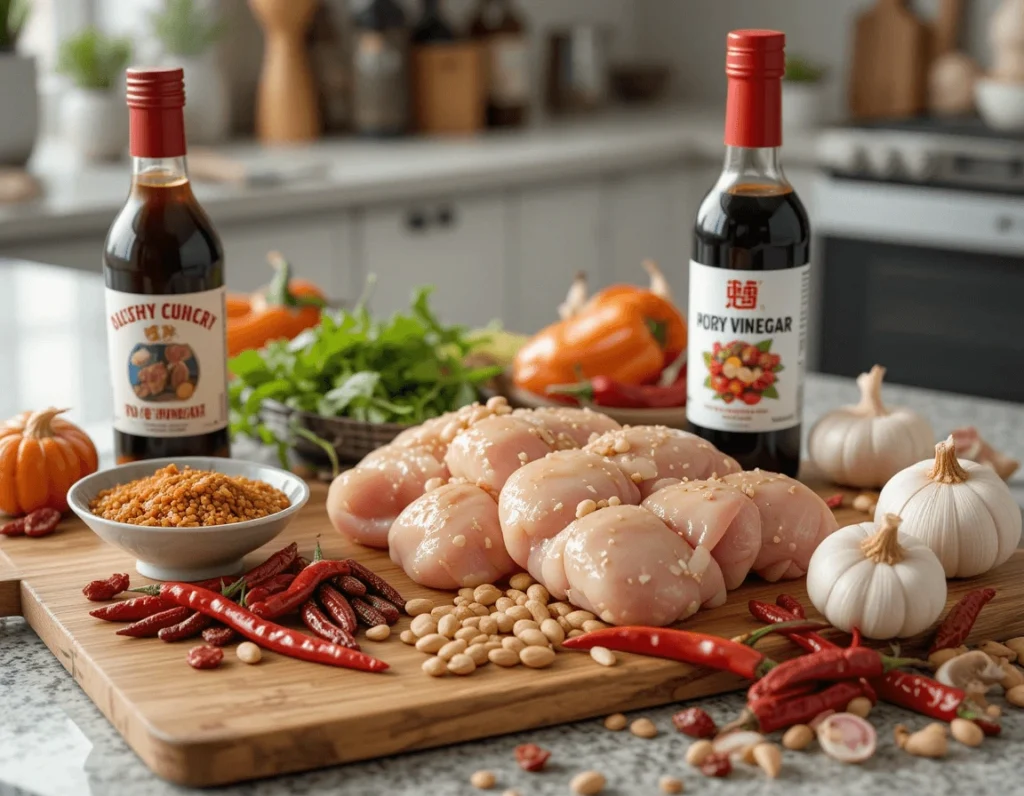
What is Usually in Kung Pao Chicken?
Kung Pao Chicken consists of several key ingredients that come together to create its signature flavor. The primary components are:
| Ingredient | Description |
|---|---|
| Chicken | Usually boneless, skinless chicken breast or thigh |
| Peanuts | Roasted or fried peanuts provide a crunchy texture |
| Dried Chilies | Provides the heat, typically dried red chilies |
| Vegetables | Bell peppers, onions, and sometimes zucchini |
| Soy Sauce | A salty base for the sauce |
| Rice Vinegar | Adds acidity and tanginess |
| Ginger and Garlic | Adds aromatic flavors to the dish |
Other variations of the dish may include different vegetables or other proteins, but these ingredients are the heart of the classic recipe.
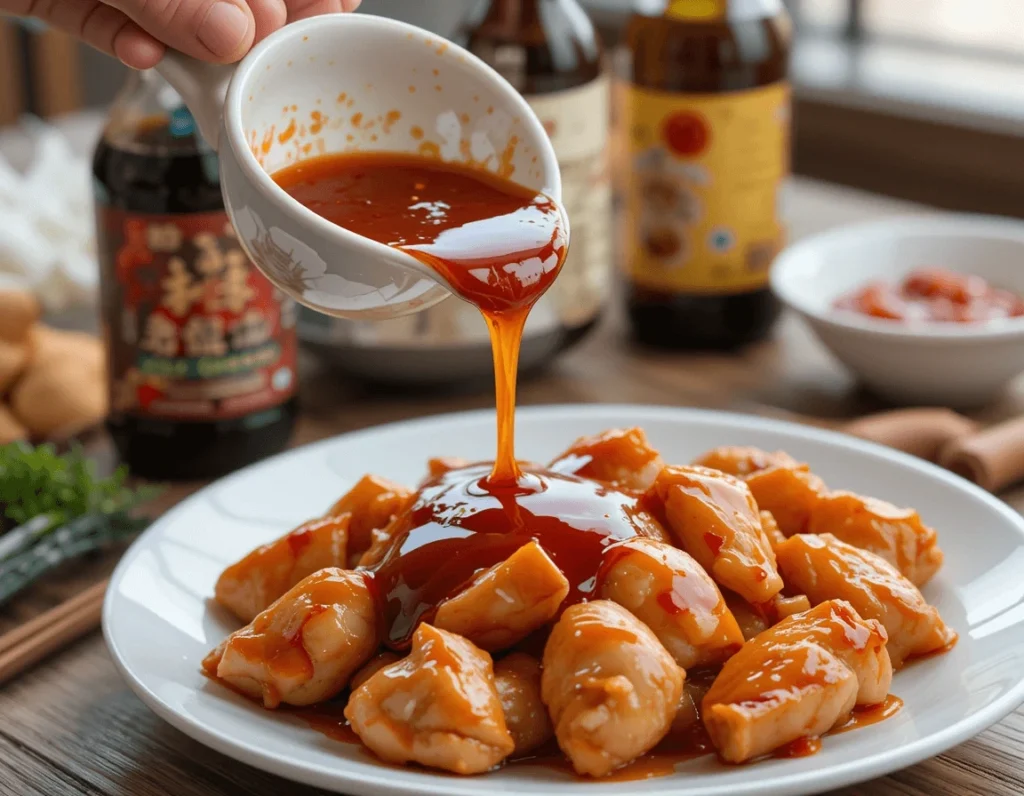
What is the Taste of Kung Pao Chicken?
Kung Pao Chicken is known for its bold and vibrant taste. The combination of the salty soy sauce, sweet sugar or honey, spicy chilies, and aromatic ginger and garlic creates a dynamic flavor experience. Here’s a breakdown of the taste profile:
| Taste Element | Description |
|---|---|
| Sweet | The sweetness from sugar or honey balances the heat |
| Savory | Soy sauce gives the dish its rich umami flavor |
| Spicy | The dried chilies provide the primary heat in the dish |
| Tangy | Rice vinegar adds a zesty and refreshing tang |
This perfect balance makes Kung Pao Chicken an irresistible dish that can be enjoyed by everyone, from spice lovers to those who prefer milder flavors.
PART 4: Is Kung Pao Chicken Really Spicy?
Kung Pao Chicken can range from mildly spicy to very hot, depending on the amount and type of chilies used. The level of heat is determined by:
- Type of Chili: Dried red chilies are commonly used, which offer a moderate heat. Some versions may use fresh green chilies for a sharper heat.
- Amount of Sichuan Peppercorns: These peppercorns provide a numbing sensation known as “mala” (麻辣), which adds complexity to the spice.
If you prefer a milder dish, you can reduce the number of chilies or remove the seeds. On the other hand, if you love spice, feel free to increase the number of chilies or add chili paste.
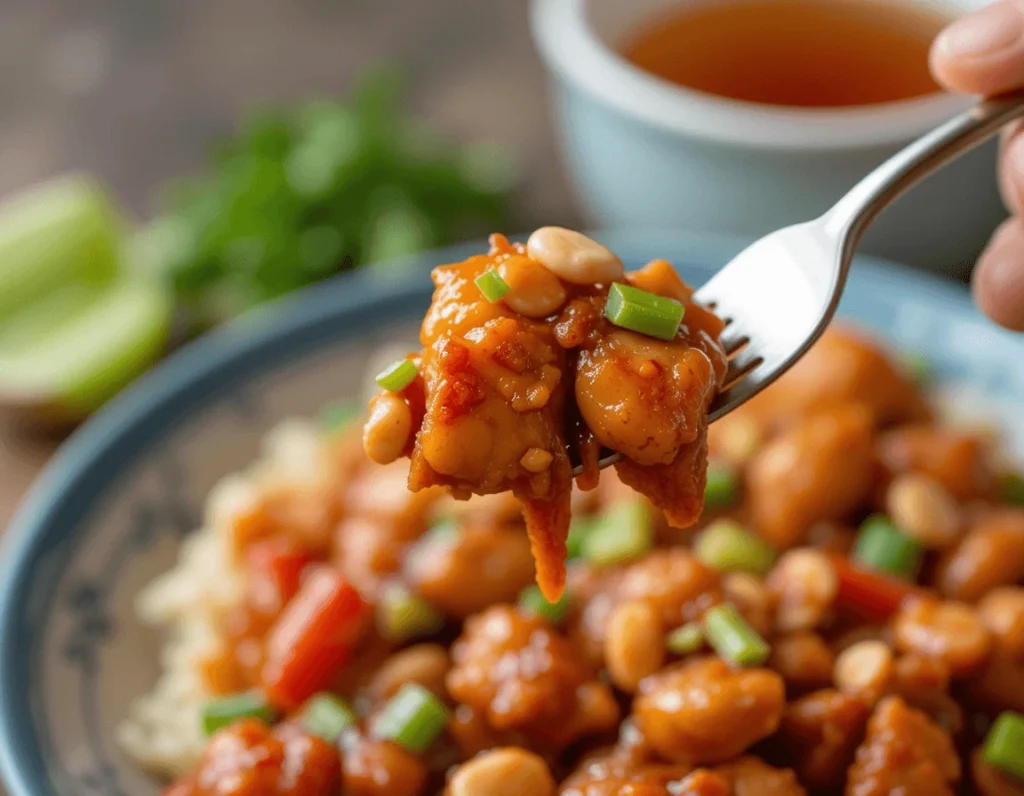
What is Kung Pao Sauce Made Of?
The Kung Pao sauce is the key to the dish’s signature taste. Here’s what it typically contains:
| Sauce Ingredient | Purpose |
|---|---|
| Soy Sauce | Provides saltiness and depth of flavor |
| Rice Vinegar | Adds acidity and tanginess |
| Sugar or Honey | Balances the saltiness and heat |
| Cornstarch | Thickens the sauce and gives it a glossy texture |
| Chili Paste | Adds heat and depth to the sauce |
| Garlic and Ginger | Enhance the overall flavor profile with aromatic notes |
The combination of these ingredients makes the sauce both flavorful and versatile, adding a delicious coating to the chicken and vegetables.
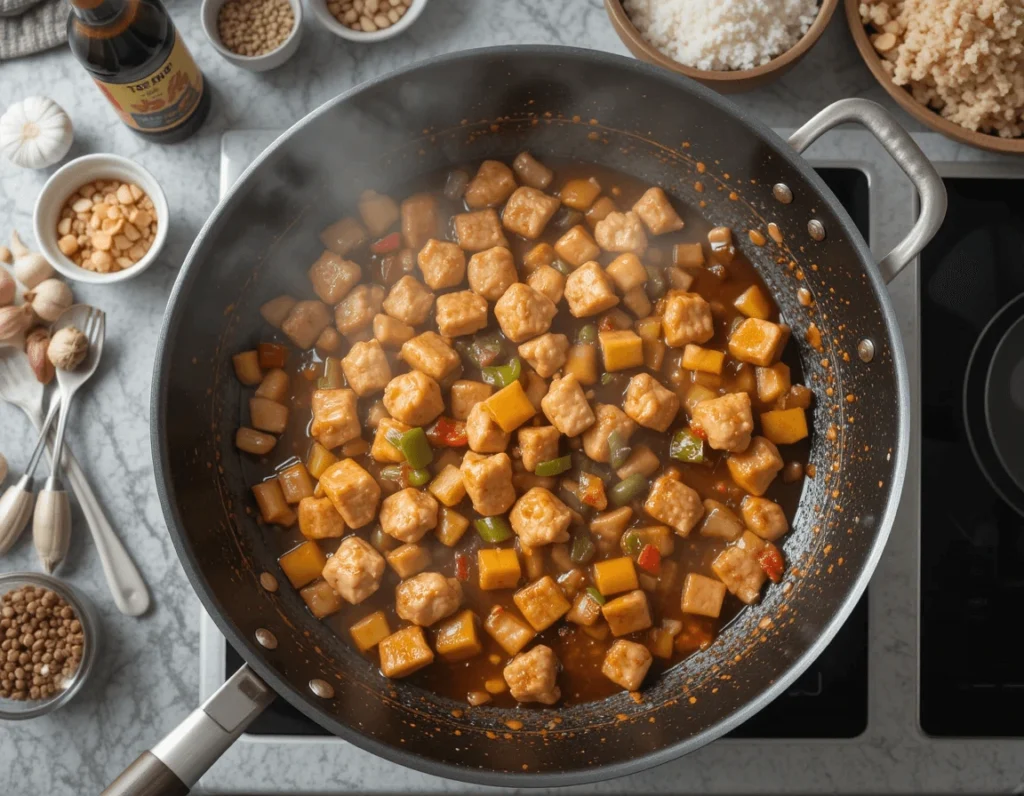
How to Make Kung Pao Chicken at Home
Making Kung Pao Chicken at home is easier than you might think! Here’s a simple recipe to try:
| Ingredient | Amount |
|---|---|
| Boneless chicken breast | 1 lb |
| Dried red chilies | 10-12 |
| Peanuts (unsalted) | 1/2 cup |
| Soy sauce | 2 tbsp |
| Rice vinegar | 1 tbsp |
| Sugar or honey | 1 tbsp |
| Cornstarch | 1 tsp |
| Garlic (minced) | 2 cloves |
| Fresh ginger (minced) | 1 tsp |
| Sichuan peppercorns | 1 tsp |
Instructions:
- Prepare the chicken: Cut the chicken into bite-sized pieces. In a bowl, mix with soy sauce and cornstarch. Let it marinate for about 10 minutes.
- Stir-fry the ingredients: Heat oil in a wok or large skillet. Add garlic, ginger, and dried chilies. Stir-fry for 1-2 minutes until fragrant.
- Cook the chicken: Add the marinated chicken and stir-fry until golden brown and cooked through.
- Prepare the sauce: In a small bowl, mix soy sauce, rice vinegar, sugar or honey, and chili paste.
- Combine: Add the peanuts and sauce to the pan, and stir well until everything is evenly coated. Cook for another 2-3 minutes until the sauce thickens.
- Serve: Serve your homemade Kung Pao Chicken with steamed rice or noodles.
Variations of Kung Pao Chicken Around the World
Kung Pao Chicken is far from a one-size-fits-all recipe. Over time, it has been modified to suit regional tastes and dietary preferences. Here are some notable adaptations that you can find across the globe:
1. Americanized Kung Pao Chicken
In the United States, this popular dish has been adapted to match local preferences. Often, it features a larger amount of sauce and less spice compared to the traditional Chinese version. Some Americanized recipes also add extra vegetables, such as carrots, mushrooms, or zucchini, and a slightly sweeter sauce to cater to American tastes. These adjustments make the dish more accessible and appeal to those who prefer a milder flavor profile.
2. Vegan Kung Pao Chicken
For those following a plant-based diet, there is a version of the dish made without animal products. Tofu, tempeh, or seitan are used as protein substitutes in place of chicken. The rest of the ingredients—such as soy sauce, peanuts, and vegetables—remain unchanged, maintaining the dish’s delicious and satisfying flavor without the use of meat.
3. Gluten-Free Kung Pao Chicken
To make Kung Pao Chicken gluten-free, simply replace soy sauce with a gluten-free alternative like tamari. Many people also use gluten-free cornstarch in place of regular cornstarch to ensure the dish is suitable for those who need to avoid gluten. This variation allows individuals with gluten intolerance to enjoy the same great flavors while adhering to their dietary needs.
4. Low-Carb Kung Pao Chicken
For those following a low-carb or ketogenic lifestyle, the traditional dish can be modified to eliminate the rice or noodles typically served with it. Instead, you can pair the dish with low-carb vegetables or simply serve it with steamed cauliflower rice. These substitutions allow the dish to remain flavorful while reducing its carbohydrate content, making it a perfect option for those watching their carb intake.
The History of Kung Pao Chicken
Kung Pao Chicken is more than just a popular dish—it has a rich and fascinating history that spans centuries. Tracing its origins back to the Qing Dynasty (1644–1912) in China, Kung Pao Chicken was initially created as a dish fit for royalty and the elite, and its journey from a local specialty to a global favorite is nothing short of remarkable.
Origin of the Name:
The name “Kung Pao” comes from Ding Baozhen, a provincial governor of Sichuan during the 19th century. Ding was given the honorary title “Kung Pao” (meaning “palatial guardian” or “palace protector”), which signified his high-ranking status. According to popular legend, Ding’s personal chefs created the dish for him, using local ingredients and their culinary expertise. The dish became known as “Kung Pao” in honor of the governor, and over time, it became synonymous with the iconic flavors we recognize today.
The Original Ingredients and Cooking Style:
Originally, Kung Pao Chicken was a simple yet flavorful dish made primarily with chicken, peanuts, and chili peppers. The ingredients were readily available in Sichuan, and the recipe was tailored to incorporate the bold, spicy flavors characteristic of Sichuan cuisine. Peanuts added a crunchy texture and a unique contrast to the tender chicken, while chili peppers brought the signature heat, making this dish spicy and flavorful. The use of soy sauce and vinegar provided a savory-sweet balance, which enhanced the dish’s depth and complexity.
The dish was traditionally stir-fried, a method that allowed the chicken to stay tender while absorbing the flavors of the sauce and spices. It was typically served to high-ranking officials and enjoyed at formal banquets, due to its rich and vibrant flavors.
Kung Pao Chicken’s Evolution in Sichuan Cuisine:
As with many dishes in Chinese cuisine, Kung Pao Chicken began as a regional specialty. It originated in Sichuan Province, known for its spicy and bold flavors, often using ingredients like Sichuan peppercorns, which create a unique numbing sensation known as “mala” (麻辣). The characteristic “mala” flavor of Kung Pao Chicken was created using both dried chili peppers and Sichuan peppercorns, a spice that is key to Sichuan’s culinary identity.
While the dish was enjoyed by Chinese elites, it was relatively unknown to the masses outside of Sichuan. However, the popularity of Chinese food around the world, especially in the United States, led to a global adaptation of Kung Pao Chicken.
The Global Spread and Western Adaptations:
Kung Pao Chicken began its journey beyond China in the early 20th century, reaching different parts of the world through Chinese immigration and the spread of Chinese cuisine globally. In particular, the United States became a major hub for the dish. As Chinese restaurants became widespread in Western countries, particularly in the United States, they adapted the recipe to suit local tastes.
Americanized Kung Pao Chicken:
In America, Kung Pao Chicken underwent some significant changes. While the original recipe remained the same at its core, several adaptations made the dish more palatable for the American audience. These changes included:
- Increased sweetness: The sauce became sweeter to cater to the American preference for sweet-sour combinations. Sugar, honey, and sometimes even ketchup were added to the sauce.
- Thicker sauce: The sauce became much thicker compared to the traditional, lighter version in China.
- More vegetables: Americanized versions of the dish often included additional vegetables like carrots, mushrooms, and zucchini, making the dish heartier and more substantial.
- Milder heat: While the dish in Sichuan is quite spicy, American versions of Kung Pao Chicken are often less spicy to accommodate local palates.
Kung Pao Chicken in China Today:
In modern-day China, Kung Pao Chicken remains a beloved dish, especially in Sichuan. It is commonly served in both restaurants and homes. However, as Chinese food culture continues to evolve, Kung Pao Chicken is now offered in a variety of versions. Some variations include using beef or shrimp instead of chicken, and some recipes may opt for tofu for a vegetarian version of the dish.
Sichuan’s Influence on the World:
Kung Pao Chicken represents just one example of the profound influence Sichuan cuisine has had on global food culture. The bold, vibrant flavors, rich use of chili peppers, and distinctive numbing-spicy combination are now widely loved and have inspired other global dishes. Thanks to its historical roots and its evolving adaptations, Kung Pao Chicken has become a symbol of Sichuan’s contribution to global culinary traditions.
The Legacy of Kung Pao Chicken:
From its humble beginnings in the Qing Dynasty to its status as a beloved dish enjoyed worldwide, Kung Pao Chicken has an impressive legacy. Today, it is one of the most popular Chinese dishes globally, often seen on the menu at Chinese restaurants in nearly every country. Its journey from a regional Sichuan dish to an international favorite reflects both the adaptability and universality of good food.
As food culture continues to evolve, Kung Pao Chicken remains a dish that celebrates the perfect balance of heat, flavor, and texture. It has cemented its place in culinary history and continues to inspire chefs and home cooks around the world.
Kung Pao Chicken is not just a dish; it’s a part of Chinese cultural history. From its creation by the chefs of Ding Baozhen in the 19th century to its widespread popularity today, it’s clear that Kung Pao Chicken is a dish that transcends borders. Whether enjoyed in its traditional form or adapted to local tastes, the dish has remained relevant and beloved across generations. Now, it’s your turn to enjoy this flavorful dish, whether you’re cooking it for the first time or perfecting your recipe.
Common Mistakes to Avoid When Making Kung Pao Chicken
Cooking Kung Pao Chicken may seem simple, but there are several common mistakes that can compromise the dish’s flavor and texture. Here are some key tips to help you avoid these pitfalls and make the perfect version of this delicious dish:
1. Using the Wrong Type of Chicken
For the best results, use boneless, skinless chicken breast or chicken thighs. It’s important to cut the chicken into small, uniform pieces to ensure even cooking. If the pieces are uneven, some may end up overcooked while others remain undercooked. A consistent size ensures that the chicken cooks uniformly and absorbs the flavors of the sauce.
2. Overcooking the Peanuts
Peanuts are a crucial ingredient in the dish, adding both texture and flavor. However, overcooking peanuts can lead to bitterness and a loss of crunch. To preserve their natural flavor, toast them lightly in a dry pan for a few minutes before adding them to the dish. This helps them stay crispy and fresh, contributing to the perfect contrast with the tender chicken.
3. Using Too Much Sauce
Balance is key when making Kung Pao Chicken. Too much sauce can overwhelm the dish, making it soggy and unbalanced. The right proportion of soy sauce, vinegar, and sugar is essential for creating a harmonious sauce that enhances the chicken without overpowering it. Always start with a moderate amount of sauce and add more if necessary.
4. Ignoring the Spice Level
While Kung Pao Chicken is known for its spicy kick, it’s important to adjust the spice level to your preference. If you’re unsure about the heat, begin with fewer dried chilies and Sichuan peppercorns. You can always add more to increase the spice as you go, but it’s difficult to dial back heat once it’s too intense.
5. Not Marinating the Chicken
A quick marinade is essential for achieving tender and flavorful chicken. Marinating the chicken with soy sauce, cornstarch, and a pinch of sugar for about 10 minutes can significantly improve the texture and taste. Skipping this step might result in chicken that’s less flavorful and less tender, which could affect the overall dish.
Pairing Drinks with Kung Pao Chicken
1. Teas
For an authentic dining experience, pair this spicy dish with a hot cup of Jasmine Tea or Oolong Tea. These teas offer a delicate balance, helping to neutralize the heat from the chilies and cleanse the palate between bites. Their subtle floral or earthy notes complement the bold flavors of the dish and enhance the overall meal experience.
2. Wine Pairings
If you prefer wine, Riesling or Gewürztraminer are great choices. Both wines have a slight sweetness combined with crisp acidity, making them ideal companions for the heat and richness of the dish. These wines will complement the savory and spicy elements without overwhelming the palate. Avoid tannic wines, as their bitterness may clash with the heat of the dish.
3. Beer Pairings
For beer lovers, a light Pilsner or a refreshing Wheat Beer can be an excellent match. These beers have a clean, crisp finish that won’t overpower the flavors of the meal. The carbonation in these beers also helps cut through the richness of the peanuts and the savory sauce, making each bite of the dish even more enjoyable.
Frequently Asked Questions (FAQs) About Kung Pao Chicken
Is Kung Pao Chicken gluten-free?
Traditionally, Kung Pao Chicken is not gluten-free because soy sauce contains wheat. However, you can substitute with a gluten-free soy sauce or tamari to make it suitable for gluten-free diets.
Can Kung Pao Chicken be made vegetarian?
Yes! You can easily make a vegetarian version of Kung Pao by replacing the chicken with tofu, tempeh, or a variety of vegetables like bell peppers, mushrooms, and zucchini.
What are the best sides to serve with Kung Pao Chicken?
Kung Pao Chicken pairs wonderfully with sides like steamed jasmine rice, fried rice, or stir-fried vegetables. You can also serve it with egg rolls or a side of soup.
Conclusion:
Kung Pao Chicken is a beloved dish that combines a rich history with a bold, complex flavor profile. Whether you’re trying it for the first time or preparing it for your family, this dish never fails to impress. Its harmonious blend of spicy, savory, and sweet elements, along with its adaptability to various dietary needs, ensures its place as a staple in Chinese cuisine worldwide.
If you’re new to making this classic recipe, don’t worry. With the right ingredients, a bit of patience, and some practice, you’ll be able to create this delicious dish with confidence. The beauty of Kung Pao Chicken lies in its versatility—you can adjust the heat level, substitute ingredients, and make it your own, all while staying true to the essence of this iconic meal.
Check out our Tasty Lunch Options for more delicious ideas.
Explore our Scrumptious Dessert Treats to complete your meal.
Print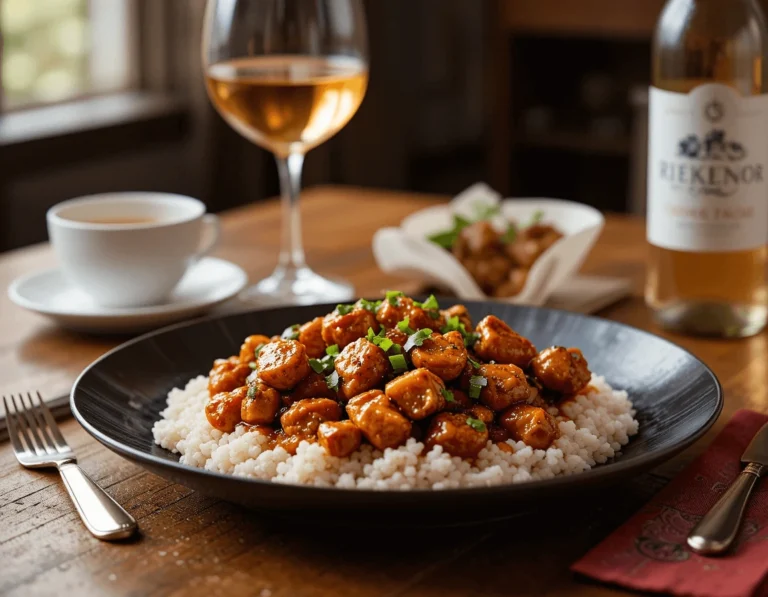
The Ultimate Guide to Kung Pao Chicken: A Flavorful Chinese Delight
Kung Pao Chicken is a flavorful and spicy dish hailing from Sichuan cuisine. With tender chicken pieces, crunchy peanuts, and a tangy sauce made of soy sauce, vinegar, and spices, this dish strikes the perfect balance of heat, flavor, and texture. Whether you’re craving something spicy or a dish that’s rich in umami, Kung Pao Chicken delivers it all. It’s the perfect dish for a family dinner or a special gathering.
- Total Time: 30 minutes
- Yield: 4 servings 1x
Ingredients
-
1 lb boneless, skinless chicken breast or thighs, cut into bite-sized pieces
-
2 tablespoons soy sauce
-
1 tablespoon cornstarch
-
1 tablespoon vegetable oil
-
1/2 cup unsalted peanuts (roasted or fried)
-
8–10 dried red chilies (adjust to taste)
-
1 bell pepper, diced
-
1 medium onion, diced
-
3 cloves garlic, minced
-
1-inch fresh ginger, minced
-
2 tablespoons soy sauce (for sauce)
-
1 tablespoon rice vinegar
-
1 tablespoon sugar or honey
-
1 teaspoon chili paste or chili sauce
-
1 tablespoon water (optional for thinning the sauce)
Instructions
-
Marinate the chicken: In a medium bowl, combine 2 tablespoons soy sauce and 1 tablespoon cornstarch. Add the chicken pieces and mix well. Let it marinate for about 10-15 minutes.
-
Prepare the sauce: In a small bowl, mix 2 tablespoons soy sauce, rice vinegar, sugar, chili paste (or sauce), and 1 tablespoon of water. Set aside.
-
Cook the chicken: Heat 1 tablespoon vegetable oil in a large wok or skillet over medium-high heat. Add the marinated chicken pieces and stir-fry until golden brown and cooked through (about 6-8 minutes). Remove from the wok and set aside.
-
Stir-fry vegetables: In the same wok, add a bit more oil if needed and sauté garlic, ginger, bell pepper, and onion for 2-3 minutes, until fragrant and tender.
-
Combine everything: Return the cooked chicken to the wok along with the peanuts and dried chilies. Add the sauce and toss everything together until well-coated, cooking for another 2 minutes until everything is heated through.
-
Serve: Serve the Kung Pao Chicken over steamed rice or noodles. Enjoy!
Notes
-
Adjust the spice level by adding more or fewer dried chilies or chili paste.
-
You can substitute chicken with tofu or shrimp for a vegetarian or seafood version.
-
If you’re avoiding gluten, use tamari instead of soy sauce to make this dish gluten-free.
-
For a more traditional flavor, add Sichuan peppercorns to the stir-fry for the signature numbing-spicy taste of Sichuan cuisine.
- Prep Time: 15 minutes
- Cook Time: 15 minutes
- Category: Dinner
- Method: Stir-fry
- Cuisine: Chinese
- Diet: Gluten Free
Nutrition
- Serving Size: 1 serving (1/4 of the dish)
- Calories: 330 kcal (per serving)
- Sugar: 8g
- Sodium: 650mg
- Fat: 20g
- Saturated Fat: 3g
- Unsaturated Fat: 12g
- Trans Fat: 9g
- Carbohydrates: 16g
- Fiber: 3g
- Protein: 27g
- Cholesterol: 70mg
Keywords: Kung Pao Chicken, Chicken Stir-Fry, Chinese Chicken Recipes, Spicy Chicken, Sichuan Cuisine, Easy Stir-Fry, Asian Chicken Dish


